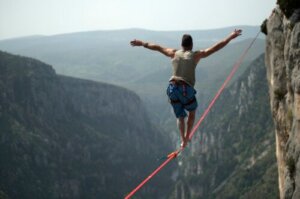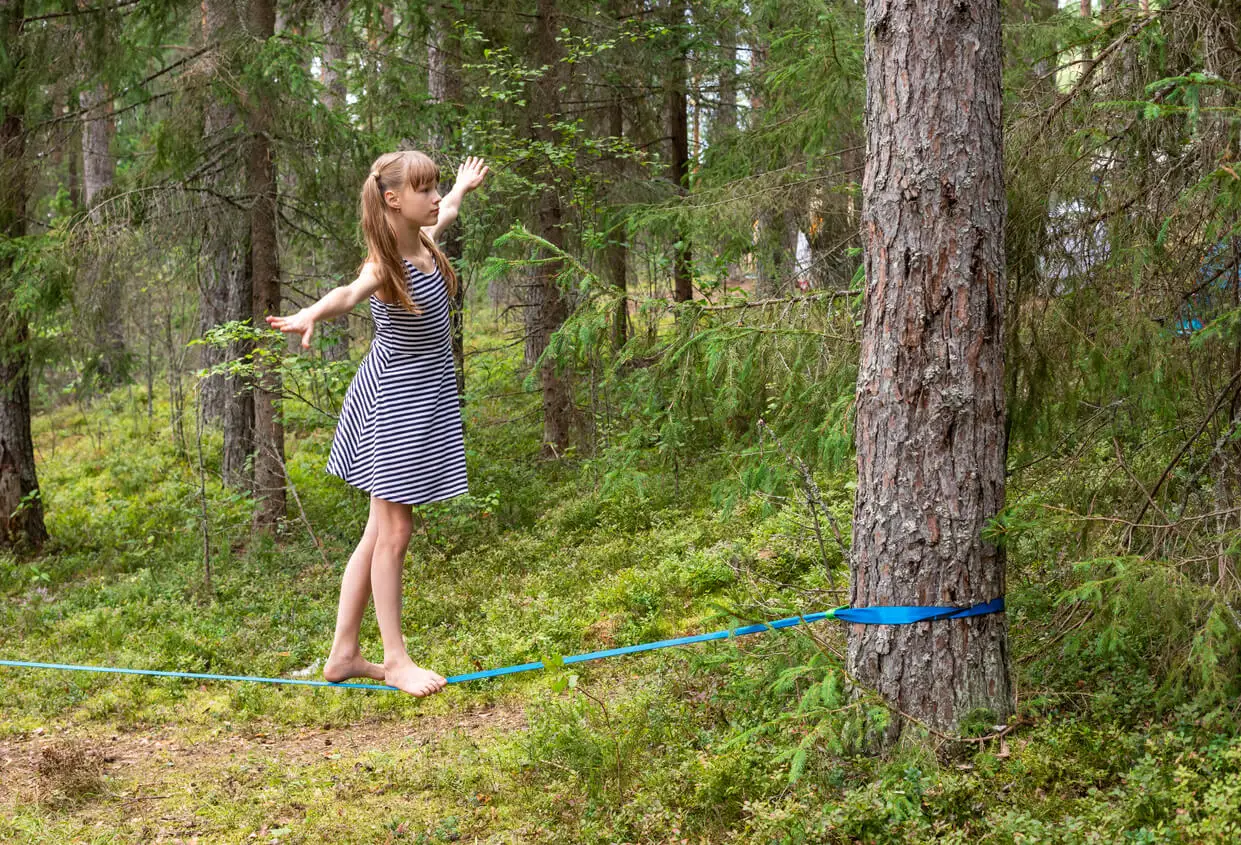Slackline Training: What Is It and What Are Its Benefits?


Reviewed and approved by the nurse Leidy Mora Molina
Walking on a rope may seem impossible at first. However, with a little practice, a lot of balance, and plenty of concentration, it can be accomplished. If you like adventure, fun and challenges, then it may be your ideal workout. Read on to find out what Slackline is and what its benefits are!
Slackline is a balance sport. It consists of walking on a rope attached to two fixed points. According to historians, this is a practice that was born as part of a climbers’ training in Yosemite Valley, California (United States).
The inventors were Jeff Ellington and Adam Grosowsky, who included it in an exercise routine to achieve better balance. It’s becoming more and more popular and is performed both professionally and for outdoor fun.
Slackline and its variants
Slackline means “tightrope”. It involves walking from one end of a rope attached to two fixed points to the other. The rope isn’t placed too taut, so it swings and adds more difficulty.
Balance, posture, and concentration are the fundamental pillars to achieve the skill. To do this exercise you don’t need too much equipment.
All you need is a nylon or polyester rope and a support to hold it to get started. In squares and parks, it’s common to see the line attached to two trees.
The following are some of the variations you can try.
Trickline, the most traditional way
For the practice of a trickling, a 5 centimeter (cm) tape is used. The line should be placed about 120 cm from the ground. The length of the course will be between 15 and 20 meters.
While the challenge for beginners will be to cross the rope, the more experienced will demonstrate their entire repertoire of jumps and skills.
Longline: A way to walk on the rope
Longline uses a rope 30 meters long and 2.5 cm wide. The exercise consists of walking on the line from one end to the other.
Special emphasis is placed on balance and concentration, since the rope isn’t placed too taut, so there’s more swinging.

We think you may be interested in reading this article, too: The Benefits of Eccentric Leg Training and 6 Recommended Exercises
Highlines: Walking on a rope at a height
This is the modality that presents the greatest risk, since the rope is attached at a height of 20 meters or more. The best thing to do is to watch the professionals and marvel at their skills.
However, if you are one of those who like extreme challenges, but don’t have enough experience, you can use safety equipment to avoid a dangerous fall. This version is ideal to admire natural landscapes and clear your mind.
Rodeoline, the most difficult modality
In this modality, the rope is barely tensioned, so the line takes a U-shape and the swing is much greater. This characteristic makes it one of the most difficult tests. The practice is also known as freestyleline.
Yoga slackline: A practice with benefits for both the body and mind
For a more advanced level of slackline, there’s this possibility. This is to do yoga asanas, but on the rope.
In this case, the line should be well-tensed to keep us on it. Connecting body, breath, and mind is also possible at height.
Waterline: Ideal for the summer
As its name suggests, a line is placed over the water. The movement adds a difficulty factor, as the line will also move. In addition to practicing it as a sport, it can be a fun game for the pool.
These are the benefits of slackline
Slackline allows us to improve our balance. However, it also offers many other advantages that will contribute to various activities of daily life.
A clear example of the benefits of slackline is presented by a study that experimented on the combination with the FIFA 11+ program in terms of neuromuscular control training. The results showed that slackline offers similar improvements and suggested that it could be an alternative approach to achieving the goals of enhanced sensorimotor control.
Here are some of the benefits of slackline:
- More balance: continuous training on the line improves balance. Walking on an unstable rope, which sways and moves with every movement, is a challenge.
- Proprioception: the body’s ability to detect the movement and position of joints, muscles, tendons and ligaments. Walking on a tightrope activates our proprioceptive system and increases reflexes.
- Increased concentration: maximum concentration is required to achieve body control and pass the test. It’s recommended to fix your eyes on a specific point to avoid distractions. In fact, some say that practicing it’s like meditating in motion.
- Better posture and control: posture is important to achieve the proper technique that allows us to walk the line. The torso should be upright and the arms stretched out to the sides, as if we were in the shape of a cross. Through a 2016 paper on balance training for older adults, it was concluded that slackline has a positive impact on reducing the risk of falls.
- Leg and core work: slackline allows us to strengthen our legs, as it works the entire lower body musculature. It also activates the core muscles.
- It reduces the risk of injury: slackline helps to strengthen the torso, and legs and work the entire middle zone, so the possibility of suffering muscular injuries decreases considerably.

Like this article? You may also like to read: Novak Djokovic: All About His Training, Yoga, and Stretching Routine
Get the ideal balance for your life
If you like challenges and adventure, slackline may be the ideal sport to test your skills. You can start in a square or a nearby park, where two trees allow you to place the rope.
As you improve, you can encourage yourself to practice it at height or in any of its variants. It’s a fun exercise that can be used as a workout or to have a good time with friends.
If you need a more balanced life, you can complement it by applying healthy habits in your daily life. You will enjoy all its benefits.
All cited sources were thoroughly reviewed by our team to ensure their quality, reliability, currency, and validity. The bibliography of this article was considered reliable and of academic or scientific accuracy.
- Jäger T, Kiefer J, Werner I, Federolf PA. Could Slackline Training Complement the FIFA 11+ Programme Regarding Training of Neuromuscular Control? Eur J Sport Sci. 2017 Sep;17(8):1021-1028. doi: 10.1080/17461391.2017.1347204. Epub 2017 Jul 6. PMID: 28682215. Disponible en: https://pubmed.ncbi.nlm.nih.gov/28682215/
-
Thomas M, Kalicinski M. The Effects of Slackline Balance Training on Postural Control in Older Adults. J Aging Phys Act. 2016 Jul;24(3):393-8. doi: 10.1123/japa.2015-0099. Epub 2015 Nov 19. PMID: 26583953. Disponible en: https://pubmed.ncbi.nlm.nih.gov/26583953/
This text is provided for informational purposes only and does not replace consultation with a professional. If in doubt, consult your specialist.








